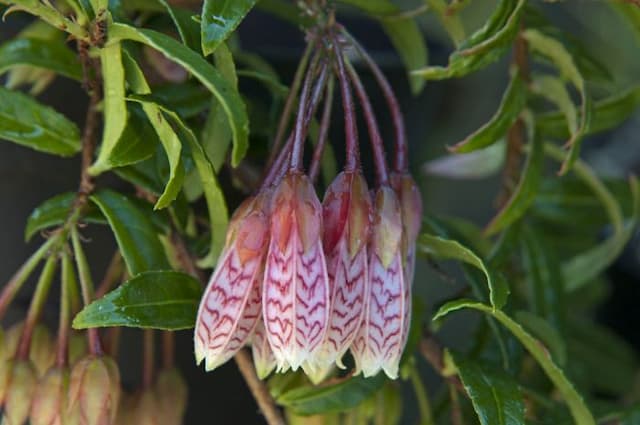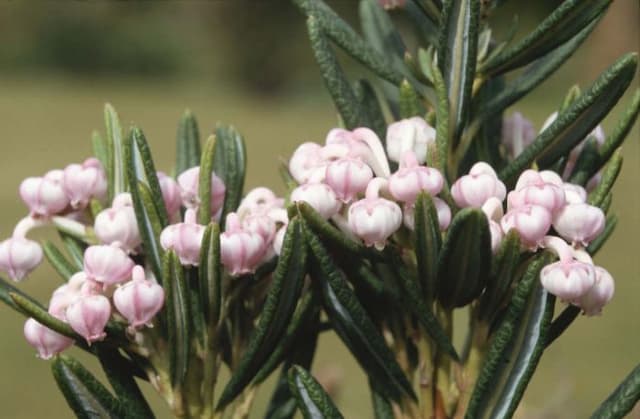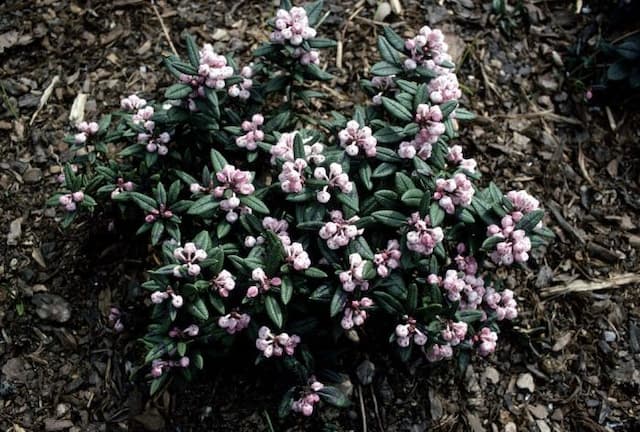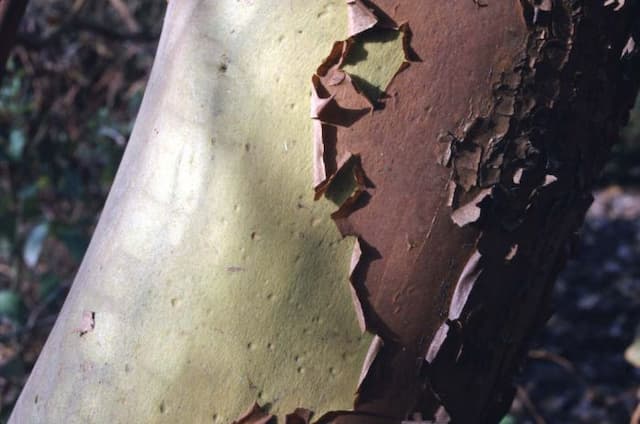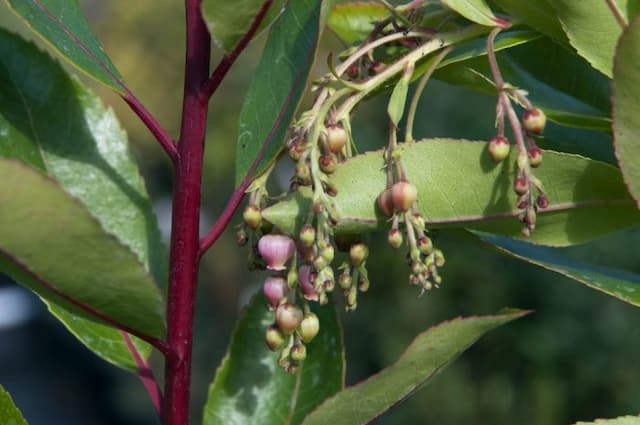Sweet Azalea Rhododendron arborescens (A)

ABOUT
The Sweet Azalea, more commonly known as Rhododendron arborescens (A), is a visually striking plant. It is adorned with large clusters of fragrant flowers that can range in color from white to pale pink, often with a yellowish blotch on the upper petal. The blossoms appear to be trumpet-shaped, which gives the plant a very distinct and decorative appearance, especially when it is in full bloom. The leaves of Sweet Azalea are also an attractive feature. They are typically elongated and have a smooth texture, presenting a deep green color that contrasts beautifully with the brightness of the flowers. In the cooler months, the foliage may take on a yellow to red hue, adding an additional layer of visual interest to the plant. This azalea has a natural grace to its shape and branching pattern, which gives it an elegant presence in the landscape. It is often found with multiple stems arising from the base, creating a bushy and full appearance. The bark is another characteristic detail; it is usually smooth with a reddish-brown tinge that peels attractively in thin layers. In addition to its visual appeal, the plant is well-loved for its scent. During the blooming season, the air around Sweet Azalea is often filled with a rich, sweet perfume, which not only attracts human admirers but also a variety of pollinators, including bees and butterflies. Overall, Sweet Azalea is a stunning plant that offers a combination of delightful flowers, aromatic scent, and beautiful foliage, making it a highly valued inclusion in gardens where it can be appreciated for its ornamental qualities.
About this plant
 Names
NamesSynonyms
Sweet Azalea, Smooth Azalea, Sweet Mountain Azalea.
Common names
Rhododendron arborescens.
 Toxicity
ToxicityTo humans
The Smooth Azalea, commonly referred to as Rhododendron arborescens, contains grayanotoxins which can be toxic if any part of the plant is ingested. Symptoms of poisoning include nausea, vomiting, weakness, dizziness, difficulty breathing, and can even lead to a drop in blood pressure or coma in severe cases.
To pets
The Smooth Azalea is also toxic to pets due to the presence of grayanotoxins. If pets ingest any part of this plant, they can experience symptoms such as vomiting, diarrhea, hypersalivation, weakness, coma, hypotension, central nervous system depression, and cardiovascular collapse. Prompt veterinary attention is required for animals that have ingested this plant.
 Characteristics
CharacteristicsLife cycle
Perennials
Foliage type
Deciduous
Color of leaves
Green
Flower color
White
Height
6-20 feet (1.8-6 meters)
Spread
6-20 feet (1.8-6 meters)
Plant type
Shrub
Hardiness zones
5
Native area
Southeastern United States
Benefits
 General Benefits
General Benefits- Landscape Aesthetics: Adds vibrant color and lush foliage to gardens and landscapes.
- Habitat Support: Offers shelter and food to various species of birds and beneficial insects.
- Erosion Control: Helps stabilize soil and prevent erosion in sloped or hilly areas.
- Seasonal Interest: Provides seasonal interest with its flowering in the spring and evergreen leaves.
- Shade Provision: Can offer shade in garden settings, making a cooler microclimate in summer.
- Cultural Significance: Valued in certain cultures for its beauty and use in traditional ceremonies and festivals.
- Biodiversity Support: Contributes to biodiversity by adding a unique genetic specimen to an ecosystem.
 Medical Properties
Medical Properties- Not applicable. This plant is not used for medical purposes.
 Air-purifying Qualities
Air-purifying QualitiesThis plant is not specifically known for air purifying qualities.
 Other Uses
Other Uses- Honey Production: Rhododendron arborescens is known to contribute to the production of "mad honey," which has psychoactive properties due to naturally occurring toxins in the flowers nectar.
- Dye Production: The flowers and leaves of Rhododendron arborescens can be used to produce natural dyes for coloring fabrics and materials.
- Ornamental Use: Its attractive blooms and overall appearance make it a popular choice for ornamental planting in gardens and parks.
- Habitat for Wildlife: This plant provides shelter and food for various birds and insects, contributing to local biodiversity.
- Soil Erosion Control: Due to its substantial root system, it helps stabilize soil, especially on slopes, and prevents erosion.
- Companion Planting: Gardeners may use Rhododendron arborescens amongst other plants to create aesthetically pleasing and mutually beneficial plant groupings.
- Photography Subject: The striking flowers make the Rhododendron arborescens a favored subject for photographers, especially in natural landscapes.
- Landscape Restoration: It's occasionally used in projects aiming at restoring natural landscapes or rehabilitating degraded areas.
- Education and Research: This species is often studied in horticulture and botany education for its characteristics and adaptation to environments.
- Cultural Significance: In certain regions, the Rhododendron arborescens is celebrated as a symbol of the area and used in cultural festivities.
Interesting Facts
 Feng Shui
Feng ShuiThe Sweet Azalea is not used in Feng Shui practice.
 Zodiac Sign Compitability
Zodiac Sign CompitabilityThe Sweet Azalea is not used in astrology practice.
 Plant Symbolism
Plant Symbolism- Caution: Rhododendrons are often associated with caution because some species have toxic leaves, which could be harmful if ingested.
- Beware: This ties into the toxicity aspect and serves as a warning to others about the potential dangers the plant may pose.
- Abundance: With their lush, voluminous bloom clusters, rhododendrons symbolize abundance and wealth.
- Elegance: The showy blossoms of the Rhododendron, particularly the Sweet Azalea, are often associated with sophistication and dignified beauty.
- Homecoming: In certain cultures, rhododendrons can represent a wish for a safe return or a welcome home.
- Survival: Since they can grow in harsh mountainous regions, they also represent resilience and the ability to thrive under difficult conditions.
 Water
WaterSmooth Azalea should be watered deeply, ensuring the water reaches the root zone, typically once a week during active growth periods in spring and summer. During hot spells or periods of drought, it might be necessary to water twice a week. The soil should feel damp at a depth of a few inches, indicating sufficient water has been applied. During the fall and winter, watering frequency should be reduced to prevent waterlogging, as this can lead to root rot. A good rule of thumb is to provide about 1 gallon of water per watering for each foot of plant height, ensuring even soil moisture.
 Light
LightFor optimal growth, Smooth Azalea prefers partial shade with some dappled sunlight. It thrives best in a spot that receives protection from the harsh afternoon sun, which can scorch the leaves. An eastern or northern-facing location that gets gentle morning light and some afternoon shade would be ideal to maintain the health and vibrant blooms of the plant.
 Temperature
TemperatureSmooth Azalea thrives in temperate climates and can tolerate minimum temperatures down to about 0°F. The ideal temperature range for this plant is between 50°F and 75°F. It can struggle or may suffer damage if exposed to temperatures above 90°F for prolonged periods, so it's important to protect it from extreme heat.
 Pruning
PruningPrune Smooth Azalea to maintain shape and encourage bushier growth immediately after blooming, as they start setting next year's flower buds soon after. Remove any dead or diseased branches, and thin out dense areas to allow light and air to reach the center of the plant. Annual pruning is typically sufficient for maintaining a healthy and aesthetically pleasing plant.
 Cleaning
CleaningAs needed
 Soil
SoilThe Sweet Azalea prefers acidic soil with a pH of 4.5 to 6.0. A mix containing 50% peat moss or pine bark and 50% perlite or coarse sand is ideal to ensure good drainage and aeration while retaining moisture.
 Repotting
RepottingSweet Azalea should be repotted every 2 to 3 years or when it outgrows its current pot, best done in late winter or early spring before new growth begins.
 Humidity & Misting
Humidity & MistingSweet Azaleas thrive at higher humidity levels, around 60-70% is optimal. They appreciate a moist environment but not wet foliage.
 Suitable locations
Suitable locationsIndoor
For Sweet Azalea, bright, indirect light, high humidity, and cool temps.
Outdoor
Plant Sweet Azalea in dappled shade, protected from strong winds.
Hardiness zone
5-9 USDA
 Life cycle
Life cycleRhododendron arborescens, commonly known as smooth azalea, begins its life cycle when seeds disperse in the environment, often with the help of wind or animals. Upon finding a suitable location with acidic soil and partial sunlight, the seeds germinate, developing into seedlings with basic root systems and leaves for photosynthesis. As the smooth azalea seedlings grow, they progress into a vegetative state, forming woody stems and larger leaf structures, while establishing a more extensive root network. During the spring, mature plants produce fragrant, white flowers which are pollinated by insects, leading to seed set within the floral chambers. Once seeds mature, they are released to start a new generation, closing the reproductive cycle. Throughout its life, the smooth azalea goes through periods of dormancy in the winter, with growth resuming in spring.
 Propogation
PropogationPropogation time
Spring-Early Summer
Propogation: The most popular method of propagation for the Rhododendron arborescens, commonly known as the Sweet Azalea, is through semi-hardwood cuttings. This technique is typically carried out in late summer, after new growth has begun to mature and harden slightly. To propagate Sweet Azalea using semi-hardwood cuttings, a gardener should select healthy, disease-free stems and make a cutting of about 4 to 6 inches (approximately 10 to 15 centimeters) long. The bottom leaves are removed, and the cut end is often dipped in rooting hormone to encourage root development. The cutting is then placed in a well-draining rooting medium, such as a mix of peat and perlite, and kept under high humidity and indirect light until roots have formed, which usually takes several weeks. Regular monitoring for moisture level is important to ensure the cuttings do not dry out or become waterlogged.
